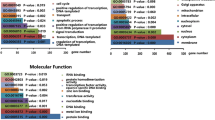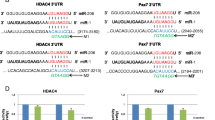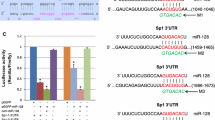Abstract
Myogenic satellite cells are stem cells responsible for muscle growth and regeneration. MicroRNAs (miRNAs) play significant roles in regulating numerous cellular processes. Two genes essential to satellite cell function are syndecan-4 and glypican-1. To determine if miRNAs influence myogenic satellite cell function, one miRNA predicted to bind syndecan-4 (miR-128) and two predicted to bind glypican-1 (miR-24 and miR-16) were inhibited in vitro by transfection of inhibitors targeting each miRNA. Inhibition of these miRNAs differentially affected the expression of syndecan-4, glypican-1, and myogenic regulatory factors myoD and myogenin. Inhibition of miR-16 reduced proliferation of satellite cells at 72 h. Inhibition of miR-128 and miR-24 did not affect proliferation. Inhibition of miRNAs reduced differentiation of satellite cells into myotubes at 48 and 72 h except for miR-16, which only affected differentiation at 72 h. Inhibition of all three miRNAs decreased myotube width at 24 h of differentiation and increased myotube width at 48 h of differentiation. Inhibiting these miRNAs also increased the number of nuclei per myotube at 72 h of differentiation. These data demonstrate individual miRNAs regulate genes essential for myogenic satellite cell proliferation and differentiation.










Similar content being viewed by others
References
Smith JH (1963) Relation of body size to muscle cell size and number in the chicken. Poult Sci 42:283–290
Moss FP, LeBlond CP (1971) Satellite cells as the source of nuclei in muscles of growing rats. Anat Rec 170:421–435
Mauro A (1961) Satellite cell of skeletal muscle fibers. J Biophys Biochem Cytol 9:493–495
Campion DR (1984) The muscle satellite cell: A review. Int Rev Cytol 87:225–251
Asakura A, Komaki M, Rudnicki M (2001) Muscle satellite cells are multipotential stem cells that exhibit myogenic, osteogenic and adipogenic differentiation. Differentation 68:245–253
Shefer G, Wieklinski-Lee M, Yablonka-Reuveni Z (2004) Skeletal muscle satellite cells can spontaneously enter an alternative mesenchymal pathway. J Cell Sci 117:5393–5404
Kuang S, Rudnicki M (2008) The emerging biology of satellite cells and their therapeutic potential. Trends Mol Med 14:82–91
Schultz E (1996) Satellite cell proliferative compartments in growing skeletal muscles. Dev Biol 175:84–94
Kuang S, Kuroda K, Le Grand F, Rudnicki M (2007) Asymmetric self-renewal and commitment of satellite stem cells in muscle. Cell 129:999–1010
Beauchamp JR, Heslop L, Yu D, Tajbakhsh S, Kelly RG, Wernig A, Buckingham ME, Partridge TA, Zammit PS (2000) Expression of CD34 and Myf5 defines the majority of quiescent adult skeletal muscle satellite cells. J Cell Biol 151:1221–1233
Seale P, Sabourin LA, Giris-Gabardo A, Mansouri A, Gruss P, Rudnicki MA (2000) Pax7 is required for the specification of myogenic satellite cells. Cell 102:777–786
Zammit PS, Beauchamp JR (2001) The skeletal muscle satellite cell: Stem cell or son of stem cell? Differentiation 68:193–204
Olguin HC, Olwin BB (2004) Pax-7 up-regulation inhibits myogenesis and cell cycle progression in satellite cells: a potential mechanism for self-renewal. Dev Biol 275:375–388
Halevy O, Pietsun Y, Allouh MZ, Rosser B, Rinkevitch Y, Reshef R, Rozenboim I, Wlekinski M, Yablonka-Reunevi Z (2004) The pattern of Pax7 expression during myogenesis in the posthatch chicken establishes a model for satellite cell differentiation. Dev Dyn 231:489–502
Yablonka-Reuveni Z, Rivera AJ (1994) Temporal expression of regulatory and structural muscle proteins during myogenesis of satellite cells on isolated adult rat fibers. Dev Biol 164:588–603
Brandan E, Larraín J (1998) Heparan sulfate proteoglycans during terminal skeletal muscle differentiation: Possible functions and regulation of their expression. Basic Appl Myol 8:107–114
Cornelison DDW, Filla MS, Stanley HM, Rapraeger AC, Olwin BB (2001) Syndecan-3 and syndecan-4 specifically mark skeletal muscle satellite cells and are implicated in satellite cell maintenance and muscle regeneration. Dev Biol 239:79–94
Cornelison DDW, Wilcox-Adelman SA, Goetinck PF, Rauvala H, Rapraeger AC, Olwin BB (2004) Essential and separable roles for syndecan-3 and syndecan-4 in skeletal muscle development and regeneration. Genes Dev 18:2231–2236
McFarland DC, Liu X, Velleman SG, Zeng C, Coy CS, Pesall JE (2003) Variation in fibroblast growth factor response and heparan sulfate proteoglycan production in satellite cell populations. Comp Biochem Phys Part C 134:341–351
Liu C, McFarland DC, Nestor KE, Velleman SG (2006) Differential expression of membrane-associated heparan sulfate proteoglycans in the skeletal muscle of turkeys with different growth rates. Poult Sci 85:422–428
Zhang X, Liu C, Nestor KE, McFarland DC, Vellaman SG (2007) The effect of Glypican-1 glycosaminoglycan chains on turkey myogenic satellite cell proliferation, differentiation and fibroblast growth factor 2 responsiveness. Poult Sci 86:2020–2028
Gutiérrez J, Brandan E (2010) A novel mechanism of sequestering fibroblast growth factor 2 by glypican lipid rafts, allowing skeletal muscle differentiation. Mol Cell Biol 30:1634–1639
Velleman SG, Zhang X, Coy CS, Song Y, McFarland DC (2010) Changes in satellite cell proliferation and differentiation during turkey muscle development. Poult Sci 89:709–715
Velleman SG, Song Y, Shin J, McFarland DC (2013) Modulation of turkey myogenic satellite cell differentiation through the shedding of Glypican-1. Comp Biochem Physiol Part A 164:1636–1643
Harthan LB, McFarland DC, Velleman SG (2013) The effect of syndecan-4 and glypican-1 expression on age-related changes in myogenic satellite cell proliferation, differentiation and fibroblast growth factor 2 responsiveness. Comp Biochem and Physiol Part A 166:590–602
Harthan LB, McFarland DC, Velleman SG (2013) Changes in proliferation, differentiation, fibroblast growth factor 2 responsiveness and expression of Syndecan-4 and Glypican-1 with turkey satellite cell age. Dev Growth Diff 55:622–634
Velleman SG, Shin J, Li X, Song Y (2012) Review: the skeletal muscle extracellular matrix: possible roles in the regulation of muscle development and growth. Can J Anim Sci 92:1–10
Velleman SG, McFarland DC (2014) Chapter 16: skeletal muscle. In: Scanes CG (ed) Sturkie’s Avian Physiology, 6th edn. Elsevier Inc., Boston, pp 379–402
Velleman SG, Liu C, Coy CS, McFarland DC (2007) Effect of Syndecan-1, Syndecan-4 and Glypican-1 on turkey muscle satellite cell proliferation, differentiation, and responsiveness to fibroblast growth factor 2. Poult Sci 86:1406–1413
Song Y, Nestor KE, McFarland DC, Velleman SG (2010) Effect of Glypican-1 covalently attached chains on turkey myogenic satellite cell proliferation, differentiation, and fibroblast growth factor 2. Poult Sci 89:123–134
Shin J, McFarland DC, Velleman SG (2012) The heparan sulfate proteoglycans, Syndecan-4 and Glypican-1, differentially regulate myogenic regulatory transcription factors and paired box 7 expression during turkey satellite cell myogenesis. Poult Sci 91:201–207
Shin J, Song Y, McFarland DC, Velleman SG (2012) Function of the Syndecan-4 cytoplasmic domain in oligomerization and association with α-actinin in turkey muscle satellite cells. Mol Cell Biochem 363:437–444
Shin J, McFarland DC, Velleman SG (2013) Migration of turkey muscle satellite cells is enhanced by the Syndecan-4 cytoplasmic domain through the activation of RhoA. Mol Cell Biochem 375:115–130
Dollenmeier P, Turner DC, Eppenberger HM (1981) Proliferation and differentiation of chick skeletal muscle cells cultured in a chemically defined medium. Exp Cell Res 135:47–61
Rudnicki MA, Schnegelsberg PNJ, Stead RH, Braun T, Arnold H, Jaenisch R (1993) MyoD or Myf-5 is required for the formation of skeletal muscle. Cell 75:1351–1359
Brunetti AB, Goldfine ID (1990) Role of Myogenin in myoblast differentiation and its regulation by fibroblast growth factor. J Biol Chem 265:5960–5963
Osses N, Brandan E (2002) ECM is required for skeletal muscle differentiation independently of muscle regulatory factor expression. Am J Physiol Cell Physiol 282:C383–C394
Ameres SL, Zamore PD (2013) Diversifying microRNA sequence and function. Nat Rev 14:475–488
Finnegan E, Pasquinelli A (2013) MicroRNA biogenesis: regulating the regulators. Crit Rev Biochem Mol Biol 48:51–68
Chen JF, Tao Y, Li J, Deng Z, Yan Z, Xiao X, Wang D (2010) microRNA-1 and microRNA-206 regulate skeletal muscle satellite cell proliferation and differentiation by repressing Pax7. J Cell Biol 190:867–869
Dey B, Gagan J, Dutta A (2011) miR-206 and -489 induce myoblast differentiation by downregulating Pax7. Mol Cell Bio 31:203–214
Cheung TH, Quach NL, Charville GW, Liu L, Park L, Edalati A, Yoo B, Hoang P, Rando T (2012) Maintenance of muscle stem-cell quiescence by microRNA-489. Nature 482:524–528
Koning M, Werker P, van Luyn M, Krenning G, Harmsen M (2012) A global downregulation of microRNAs occurs in human quiescent satellite cells during myogenesis. Differentiation 84:314–321
Chen JF, Mandel EM, Thomson JM, Wu Q, Callis TE, Hammond SE, Conlon FL, Wang D (2006) The role of microRNA-1 and microRNA-133 in skeletal muscle proliferation and differentiation. Nat Genet 38:228–233
Kim HK, Lee YS, Sivaprasad U, Malhora A, Dutta A (2006) Muscle-specific microRNA miR-206 promotes muscle differentiation. J Cell Biol 174:677–687
Koning M, Werker P, van der Schaft D, Bank R, Harmsen MC (2012) MicroRNA-1 and microRNA-206 improve differentiation potential of human satellite cells: a novel approach for tissue engineering of skeletal muscle. Tissue Eng Part A 18:889–898
Dovas A, Yoneda A, Couchman JR (2006) PKCα-dependent activation of RhoA by Syndecan-4 during focal adhesion formation. J Cell Sci 119(13):2837–2846
Velleman SG, Liu X, Nestor KE, McFarland DC (2000) Heterogeneity in growth and differentiation characteristics in male and female satellite cells isolated from turkey lines with different growth rates. Comp Biochem Physiol Part A 125:503–509
The European Bioinformatics Institute: MicroCosm Targets, version 5. http://www.ebi.ac.uk/enright-srv/microcosm/htdocs/targets/v5/. Accessed on 1 May 2014
McFarland DC, Pesall JE, Gilkerson KK, Ferrin N (1995) The response to growth factors of cultured satellite cells derived from turkeys having different growth rates. Cytobios 82:229–238
Yun Y, McFarland DC, Pesall JE, Gilkerson KK, Vander Wal LS, Ferrin NH (1997) Variation in response to growth factor stimuli in satellite cell populations. Comp Biochem Physiol 117A:463–470
SAS Institute Inc. (2011) Sas/stat® 9.3 user’s guide. SAS Inst Inc., Cary, NC
Li J, Gonzalez JM, Walker DK, Hersom MJ, Ealy AD, Johnson SE (2011) Evidence of heterogeneity within bovine satellite cells isolated from young and adult animals. J Anim Sci 89:1751–1757
Baroffio A, Bochaton-Piallat M-L, Gabbiani G, Bader CR (1995) Heterogeneity in the progeny of single human muscle satellite cells. Differentiation 59:259–268
Krek A, Grün D, Poy MN, Wolf R, Rosenberg L, Epstein EJ, MacMenamin P, da Piedade I, Gunsalus KC, Stoffel M, Rajewsky N (2005) Combinatorial microRNA target predictions. Nat Genetics 37:495–500
Miska E, Alvarez-Saavedra E, Abbott A, Lau N, Hellman A, McGonagle S, Bartel D, Ambros V, Horvitz R (2007) Most Caenorhabditis elegans micoRNAs are individually not essential for development or viability. PLoS Genet 3:e215
Selbach M, Schwanhausser B, Theirfelder N, Fang Z, Khanin R, Rajewsky N (2008) Widespread changes in protein synthesis induced by microRNAs. Nature 455:58–63
Sanchez N, Gallagher M, Lao N, Gallagher C, Clarke C, Doolan P, Aherne S, Blanco A, Meleady P, Clynes M, Barron N (2013) miR-7 triggers cell cycle arrest at the G1/S transition by targeting multiple genes including Skp2 and Psme3. PLoS One 8:e65671
Chamorro-Jorganes A, Araldi E, Rotllan N, Cirera-Salinas D, Suárez Y (2014) Autoregulation of glypican-1 by intronic microRNA-149 fine tunes the angiogenic response to FGF2 in human endothelial cells. J Cell Sci 127:1169–1178
Sun Q, Zhang Y, Yang G, Chen X, Zhang Y, Cao G, Wang J, Sun Y, Zhang P, Fan M, Shao N, Yang X (2008) Transforming growth factor-β-regulated miR-24 promotes skeletal muscle differentiation. Nucleic Acid Res 36:2609–2699
Amelio I, Lena AM, Viticchiè G, Shalom-Feuerstein R, Terrinoni A, Dinsdale D, Russo G, Forunato C, Bonanno E, Spagnoli LG, Aberdam D, Knight RA, Cani E, Melino G (2012) miR-24 triggers epidermal differentiation by controlling actin adhesion and cell migration. J Cell Biol 199:347–363
McFarland DC (1999) Influence of growth factors on myogenic satellite cells. Poult Sci 78:747–758
Halevy O, Geyra A, Barak M, Uni Z, Sklan D (2000) Early posthatch starvation decreases satellite cell proliferation and skeletal muscle growth in chicks. J Nutr 130:858–864
O’Rourke JR, Georges SA, Seay HR, Tapscott SJ, McManus MT, Goldhamer DJ, Swanson MS, Harfe BD (2007) Essential role for Dicer during skeletal muscle development. Dev Biol 311:359–368
Florini JR (1989) Assay of creatine kinase in microliter plates using thio-NAD to allow monitoring at 405 nm. Anal Biochem 182:399–404
Chamberlain JS, Jaynes JB, Hauschka SD (1985) Regulation of creatine kinase induction in differentiating mouse myoblasts. Mol Cell Biol 5:484–492
Wallimann T, Wyss M, Brdiczka D, Nicolay K, Eppenberger HM (1992) Intracellular compartmentation, structure and function of creatine kinase isoenzymes in tissues with high and fluctuating energy demands: the ‘phosphocreatine circuit’ for cellular energy homeostasis. Biochem J 281:21–40
Acknowledgments
The authors would like to thank Dr. William Weiss (The Ohio State University/Ohio Agricultural Research and Development Center, Wooster, OH) for assistance with the statistical analyses.
Author information
Authors and Affiliations
Corresponding author
Rights and permissions
About this article
Cite this article
Harding, R.L., Velleman, S.G. MicroRNA regulation of myogenic satellite cell proliferation and differentiation. Mol Cell Biochem 412, 181–195 (2016). https://doi.org/10.1007/s11010-015-2625-6
Received:
Accepted:
Published:
Issue Date:
DOI: https://doi.org/10.1007/s11010-015-2625-6




